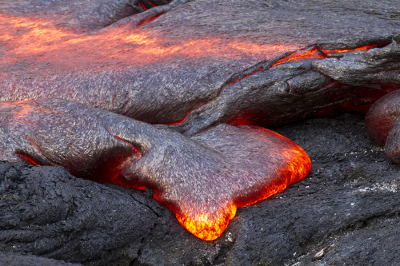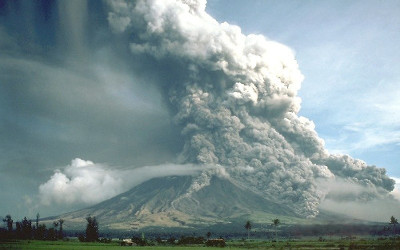Rocha ígnea extrusiva
English
COMPARTILHAR
Visão Geral
Fonte: Laboratório de Alan Lester – Universidade de Colorado Boulder
Rochas ígneas são produtos de resfriamento e cristalização de magma. Rochas vulcânicas são uma variedade particular de rocha ígnea, formando-se como consequência do magma rompendo a superfície, depois resfriando e cristalizando no ambiente subaerial.
Magma é rocha líquida que normalmente varia em temperatura de aproximadamente 800 °C a 1.200 °C(Figura 1). O magma em si é produzido dentro da Terra através de três mecanismos primários de fusão, a adição de calor, adição de voláteis e descompressão. Cada modo de geração de derretimento tende a produzir tipos específicos de magma e, portanto, estilos e estruturas eruptivas distintas.

Figura 1. Fuga de lava fresca em Kilauea, Havaí. Lava é o termo para magma que está na superfície da Terra.
Princípios
Procedimento
Resultados
1. CO2 Volcano
During the CO2 experiment, some of the material will flow outwards like a lava flow. The frothy nature of the flow is reminiscent of lava that is charged with volatiles. Most volcanic eruptions are linked to volatile loss. Those that are particularly explosive will have considerable volatile emanations. If the container is corked, then the initial eruption will involve pyroclastic-type material that is ejected into the air above the volcanic edifice.
2. Volcanic Layering
With the volcanic layering experiment complete, note that the layers thin with distance from the magma source. This is a phenomenon that would be commonly seen in volcanoes. It can also be seen that subsequent layers can partially melt the underlying layer. The principle of superposition can also be observed in the demonstration, where older layers are found on the bottom, younger layers atop.
Applications and Summary
Volcanism and associated rocks are of great interest to geologists. Not only do volcanic eruptions pose a threat to nearby communities, it is important to recognize that they can also lead to scenic landscapes, and positively influence soil and agricultural productivity.
Recognizing volcanic rocks in the field, linking them to specific eruptive styles, and ascertaining regions of past activity are part of fundamental geologic assessments for regions in which people live and/or work. Volcanic rocks can be indicators of past eruptive activity. The types of volcanic rocks present can also be used to evaluate the severity and explosivity of past eruptions. Understanding the potential types of eruptions (e.g. lava flows (Figure 1), ash, pyroclastic flows (Figure 3)) that might occur in a volcanic region are a crucial part of developing mitigation strategies.

Figure 3. Pyroclastic flows sweep down the flanks of the Mayon Volcano, Philippines, 1984.
Volcanic layering can also be a window into a “page-by-page” history of a region. Volcanic layers can contain information about past climate, environment, and even life. In particular, volcanic layers are relatively easy to date (unlike sedimentary layers) using isotopic dating techniques. Therefore, volcanic layers are useful time-markers in geologic investigations.
Transcrição
Volcanic rock is a specific type of igneous rock that is formed when magma breaches the surface and solidifies in the subaerial environment. Its study provides insights into past, and possibly future, volcanic activity.
Magma is liquid rock, which is produced within the Earth and reaches temperatures from 800 to 1,200 °C. There are three primary mechanisms of magma production: addition of heat, addition of volatiles, or decompression. Each of these different types of melting produces specific types of magma, and therefore generate volcanoes with different eruptive styles and structure. This video will illustrate the differences between types of lava deposition on a small scale using paraffin wax, and different eruption types using a CO2 based demonstration.
Highly viscous magmas with high volatile contents tend to produce the most explosive eruptions, compared to low viscosity and low volatile content magmas, which generally produce the most quiescent eruptions.
In quiescent eruptions, lava flows off the side of the volcano or outward from fissures. Lava flows are typically slow moving, and as such may cause property damage, but rarely loss of life. In contrast, more explosive reactions result in magma, rock, and gas, collectively known as “pyroclastic material”, to be ejected from the volcano.
The type of mantle being melted, and the degree of melting, can both affect magma composition. The resultant magma formed will then affect the resulting volcano produced, and the eruption type observed.
Generally, viscous magma is more felsic in composition and forms as a result of melting of continental crust or continental lithosphere. In contrast, less viscous magma is typically mafic, and forms during melting of oceanic lithosphere or asthenopheric mantle melting. For more information on felsic and mafic rock, see this collection’s other video on Igneous Rock.
Volcanoes are typically generated by successive depositions of lava over time. Highly viscous lava creates tall, steep edifices, known as stratovolcanoes. In contrast, free-flowing lava travels further before solidifying, creating short, low-profile structures known as shield volcanoes.
Now that we are familiar with the concepts behind magma production, deposition, and volcanic eruption, let’s take a look at how these can be simulated in the laboratory.
The first procedure demonstrates quiescent and explosive eruptions. To begin, fill a plastic container with a thin neck to about half full with warm water. To simulate the structure of a volcano, bury the bottle beneath modeling clay or dough, leaving just the neck opening of the bottle exposed. Next, add roughly 4 teaspoons of baking soda.
Add vinegar to the bottle until it begins to effervesce. Including dye can aid with visibility. For a quiescent eruption leave the bottle open. If simulation of a violent eruption is desired, cork the bottle.
In the quiescent eruption, some of the material flowed outwards like a lava flow. The frothy nature of the flow is reminiscent of lava that is charged with volatiles.
Most volcanic eruptions are linked to volatile loss. Those that are particularly explosive will have considerable volatile emanations. In the corked container, the initial eruption involves pyroclastic-type material that is ejected into the air above the volcanic edifice. This also indicates what can happen in naturally blocked volcanoes.
The next demonstration relates to is lava layering. To demonstrate this, warm paraffin on a hot plate until it becomes a viscous fluid. Pour the liquid paraffin onto an inclined thin cardboard surface with bends of various shapes. This varied gradient simulates lava flow on the uneven surface of real volcanoes. As the paraffin flows over the uneven surface, it will form a layer of varying thickness, which simulates what would be seen on the surface of a real volcano. Allow the first paraffin layer to cool, then pour a second layer over the first, starting from the same point. Repeat this process several times to simulate successive lava flows.
Note how the layers thin with distance from the magma source. Also observe that subsequent hot layers or eruptions can partially melt underlying layers.
The layering demonstrates the principle of superposition. Older layers are found at the bottom, with deposits from more recent eruptions stratified above.
Additionally, the bent surface of the card simulates the uneven surface seen on most volcanoes. Different thicknesses of magma will collect on the steeper or shallower parts of the volcano surface, changing the landscape of the volcano with each successive eruption.
Understanding volcanic rock composition, formation, and the properties that lead to different eruption phenomena has vast applications for geologists and human populations as a whole.
Recognizing types of volcanic rock in the field and linking them to specific eruptive styles can inform geologists of the type of threats posed to nearby communities. This information can help with implementing eruption emergency plans, or with targeted safety construction or town planning.
Types of volcanic rock can also be studied to evaluate the severity or explosivity of past eruptions. This information can be helpful when planning land use. As volcanic deposition can also positively influence soil and agriculture, such areas may be economically fruitful if the risk of severe eruption is considered low.
Volcanic layering can be a window into the geological history of a region. Layers can contain information about past climate, environment, and life, and are easy to date, providing useful time markers in geologic investigations. Volcanoes can also create scenic landscapes, including the iconic Arthur’s Seat, which overlooks the city of Edinburgh in Scotland. This is the largest remaining part of an extinct volcano that dates back to the Carboniferous period, and is designated a Site of Special Scientific Interest.
You’ve just watched JoVE’s introduction to volcanic igneous rocks. You should now understand the different types of magma and their deposition, principles of quiescent and explosive eruptions, and how to simulate these in the laboratory or at home. Thanks for watching! Thanks for watching!
